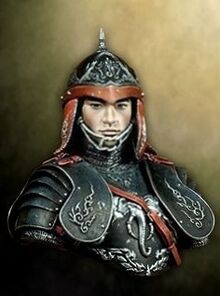First Shamabalese Great War
| First Shamabalese Great War | ||||||||
|---|---|---|---|---|---|---|---|---|
 Mutulese artillery shooting at Shamabalese War elephants | ||||||||
| ||||||||
| Belligerents | ||||||||
|
|
Template:Country data Shamabala |
| ||||||
| Casualties and losses | ||||||||
| Unknown | Heavy | Unknown | ||||||
The First Shamabalese Great War, also known as the Uluu- Mutulese War or the War for Ankat, was a conflict that opposed a coalition of Shamabaleses princes led by the Green Horde Khan to the alliance of principalities that would later form the Kingdom of Ankat. The latter were helped by the Mutul through its Nuk Nahob or “Great Companies” that had established many trade ports in the area, while the Shamabaleses Princes seeked help from Uluujol after 1641. The war lasted from 1638 to 1743, with the signature of the Naegima Accords that recognized the Kingdom of Ankat as a sovereign state, its independence guaranteed by the Mutul. The failure of the Green Horde to keep Ankat in its orbit, to repel the foreigners, and to stop the Ayvani principalities from seeking the help of Uluujol on their own, placed their legitimacy as Hegemons of Shamabala into question, naturally leading to the Atapa Revolts and the War of the Feuding Suns. These devastating conflicts would lead to a completely new political landscape in Southern Ochran.
Background
The fall of the Bayarids led to the rise of many new warlords and khanates, all competing for the creation of their own petty kingdoms or to secure their share of the old empire. Among them was Mundzuk Khan, who successfully conquered the entirety of the Shamabala Empire, a large network of feudal lords, themselves ancient vassals of the Bayarids. Mundzuk Khan kept his dominion over southern Ochran through his support of Buddhism, winning the Monasteries to his side through the granting of various privileges. This was the beginning of the Green Horde.
The Mutuleses Nuk Nahob, or “Great Companies”, first arrived in Southern Ochran during the 16th century. There, they began trading with coastal lords and princes, who all maintained their own economic policies, their submission to the Green Horde being limited to a regular tribute. The Nuk Nahob notably managed to establish trade ports in the Terasi kingdoms of the Janatava Peninsula. Relationship between the Princes and the Mutuleses were cordial, the Ochraneses selling cotton, indigos, textiles, ivory, perls and other luxury goods in exchange for exotic Oxidentaleses products such as chocolate, spices, silk, coral, feathers and sugar. This trade began to threaten the resources of the Green Horde, which was losing revenues and also seeing some of its vassals become more and more independent and wealthy and, thus, dangerous.
At the demand of a collection of princes threatened by the rise in number of trade ports and the growing influence of the Mutul, The Khan officialy published a decree ordering all Princes to stop trading with the Mutuleses, to break all contracts and treaties that binded them to the Nuk Nahob, and to close all trade ports they had opened. This mainly concerned the Janatava Peninsula, but its Princes all refused to obey the Decree, demanding an appeal of the order and that the Khan accept to receive an embassy to his Court to hear their position. Their demand was refused, and the Khan prepared to march on the Princes, declaring them rebellious.
Military forces
The Mutuleses and Terasi
At the time of the war, the future Ochk’ak Fleet was yet to be fully reformed into the well organized war machine of the Ozeros War. Instead of a permanent taskforces, there were Mutuleses agents raising troops and requisitioning vessels as it had been done during the War for Kahei. As such the Mutuleses troops that came to help their allies had a very heteroclit nature.
First in numbers were the Pulaui mercenaries. Since the end of the Age of Fire, many companies of soldiers found themselves jobless, or had lost their farms and other sources of revenues while they had been away. These experienced fighters became a staple of the Nuk Nahob war efforts. They made up the majority of the first wave of reinforcements sent by the Mutuleses, and would remain the core of the armies fielded by the Oxidentaleses traders.
Later during the war, a great number of Tsurushimeses and Polynesians companies joined in the conflict. The Mutul recruited from the Kahei Islands both sailors, soldiers, and officers. These experimented crews brought with them the most advanced equipments available to the Mutuleses, with canons and guns bought directly from the Tsurushimeses armories, and ships built in the famed shipyards of Kahei. The Polynesians, engaged either in Kahei or in the many Makrian Islands, were famed for their morale and their units formed an important minority among the Mutuleses rank-and-files, even if they were almost entirely absent from the officer corps, contrary to the Tsurushimeses and Pulaui.
The war effort was led by the sole Waterlord, or Admiral, chosen by a council of the Nuk Nahob who had direct investments in Shamabala for his experience in naval warfare. During the second half of the war, when land battles became more prominent, A Kaloomte’ (or Marechal) was chosen to coordinate the various troops on the ground. In both case the military staff was made of veterans Pulaui and Tsurushimeses Captains and Commanders, almost all of which had already served alongside or under the Nuk Nahob.
